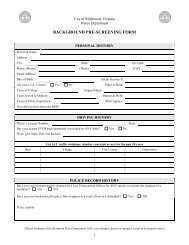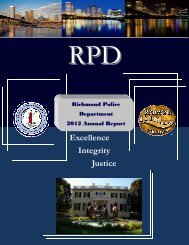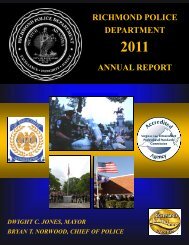Comprehensive Annual Financial Report
2012 Comprehensive Annual Financial Report - City of Richmond
2012 Comprehensive Annual Financial Report - City of Richmond
- No tags were found...
You also want an ePaper? Increase the reach of your titles
YUMPU automatically turns print PDFs into web optimized ePapers that Google loves.
A. No Overlapping Debt<br />
The City is a separate and distinct political unit and is autonomous and independent of any county or any other political<br />
subdivision of the Commonwealth. The City is not coterminous with or subject to any county or school district taxation and is not<br />
liable for any indebtedness other than its own.<br />
B. Legal Debt Margin<br />
Article VII, Section 10 of the Constitution of Virginia provides that the legal general obligation debt limit for cities is ten percent of<br />
the last preceding assessment for real estate taxes. At June 30, 2012 the City had a legal debt limit of $1,971,053,100 and the<br />
statutory capacity to issue approximately $1,270,584,308 of additional general obligation debt.<br />
The City’s legal debt margin is computed as follows:<br />
10% of Assessed Value of Taxable Real Estate as of January 1, 2012 1 $1,971,653,100<br />
Less: Bonds and Notes Payable 2,3 $701,068,792<br />
Legal Margin for Creating Additional Debt $1,270,584,308<br />
____________<br />
1<br />
Source: City Assessor for Real Estate<br />
2<br />
Does not include $556,645,429 of self-supporting City of Richmond Public Utility Revenue Bonds, $12,325,000 of<br />
Certificates of Participation and $8,360,231 of Lease Revenue Bonds that by State law are not required to be included in<br />
calculations for legal margin for creation of additional debt<br />
3<br />
As of June 30, 2012.<br />
C. Short-Term Debt<br />
In the past, the City had annually issued notes in anticipation of the receipt of personal property and real estate property taxes to<br />
finance current operations. The City has issued revenue anticipation notes in amounts ranging between $45.0 million and $75.0<br />
million with maturities of less than one year. With the successful transition to twice-a-year real estate billing in fiscal year 2011,<br />
the City ended the practice of utilizing revenue anticipation notes.<br />
The City uses a $100.0 million Commercial Paper Bond Anticipation Note Facility to provide interim financing for Capital<br />
Improvement Plan (CIP) projects. Debt issued on this facility is refinanced periodically as General Obligation Bonds. As of June<br />
30, 2012, the City had $5.94 million of Commercial Paper Notes outstanding.<br />
D. Long-Term Debt<br />
Bonds of the City, including general obligation bonds, serial equipment notes and certain public utility bonds, and commercial<br />
paper notes are direct general obligations, to which the full faith and credit of the City are pledged. The Council is authorized<br />
and required, unless other funds are lawfully available and appropriated for timely payment, to levy and collect on all property<br />
taxable by the City such ad valorem taxes as may be necessary to pay when due the principal of, premium, if any, and interest<br />
on such bonds and notes as the same shall become due and payable. The City has never defaulted in the payment of principal,<br />
premium, or interest on any debt.<br />
Enterprise Funds and Internal Service Funds pay from user fees the principal of and interest on certain general obligations<br />
bonds, revenue bonds and serial equipment notes issued for the program purposes of each fund. All other monies for the<br />
principal of and interest on such debt are appropriated in the General Fund budget. No long-term bonds are sold to finance<br />
current operations.<br />
VI
















